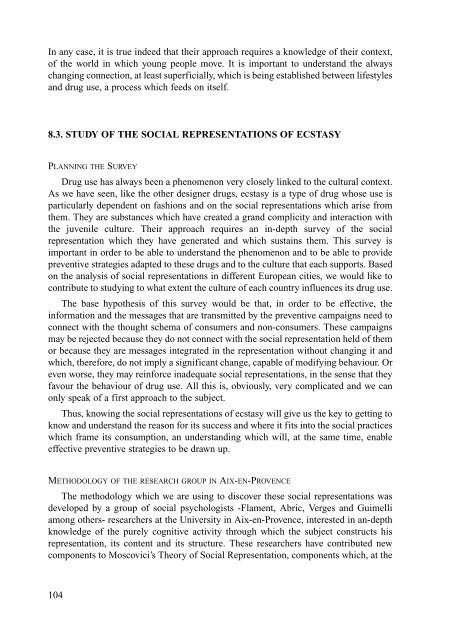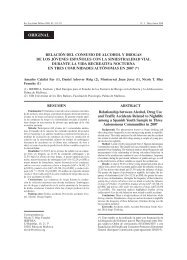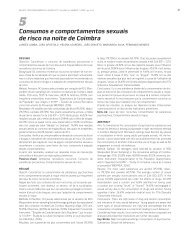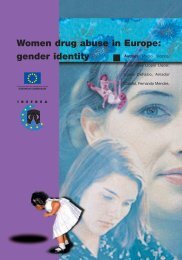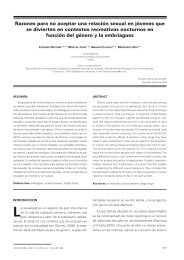Characteristics and social representation of ecstasy in Europe - Irefrea
Characteristics and social representation of ecstasy in Europe - Irefrea
Characteristics and social representation of ecstasy in Europe - Irefrea
You also want an ePaper? Increase the reach of your titles
YUMPU automatically turns print PDFs into web optimized ePapers that Google loves.
In any case, it is true <strong>in</strong>deed that their approach requires a knowledge <strong>of</strong> their context,<strong>of</strong> the world <strong>in</strong> which young people move. It is important to underst<strong>and</strong> the alwayschang<strong>in</strong>g connection, at least superficially, which is be<strong>in</strong>g established between lifestyles<strong>and</strong> drug use, a process which feeds on itself.8.3. STUDY OF THE SOCIAL REPRESENTATIONS OF ECSTASYPLANNING THE SURVEYDrug use has always been a phenomenon very closely l<strong>in</strong>ked to the cultural context.As we have seen, like the other designer drugs, <strong>ecstasy</strong> is a type <strong>of</strong> drug whose use isparticularly dependent on fashions <strong>and</strong> on the <strong>social</strong> <strong>representation</strong>s which arise fromthem. They are substances which have created a gr<strong>and</strong> complicity <strong>and</strong> <strong>in</strong>teraction withthe juvenile culture. Their approach requires an <strong>in</strong>-depth survey <strong>of</strong> the <strong>social</strong><strong>representation</strong> which they have generated <strong>and</strong> which susta<strong>in</strong>s them. This survey isimportant <strong>in</strong> order to be able to underst<strong>and</strong> the phenomenon <strong>and</strong> to be able to providepreventive strategies adapted to these drugs <strong>and</strong> to the culture that each supports. Basedon the analysis <strong>of</strong> <strong>social</strong> <strong>representation</strong>s <strong>in</strong> different <strong>Europe</strong>an cities, we would like tocontribute to study<strong>in</strong>g to what extent the culture <strong>of</strong> each country <strong>in</strong>fluences its drug use.The base hypothesis <strong>of</strong> this survey would be that, <strong>in</strong> order to be effective, the<strong>in</strong>formation <strong>and</strong> the messages that are transmitted by the preventive campaigns need toconnect with the thought schema <strong>of</strong> consumers <strong>and</strong> non-consumers. These campaignsmay be rejected because they do not connect with the <strong>social</strong> <strong>representation</strong> held <strong>of</strong> themor because they are messages <strong>in</strong>tegrated <strong>in</strong> the <strong>representation</strong> without chang<strong>in</strong>g it <strong>and</strong>which, therefore, do not imply a significant change, capable <strong>of</strong> modify<strong>in</strong>g behaviour. Oreven worse, they may re<strong>in</strong>force <strong>in</strong>adequate <strong>social</strong> <strong>representation</strong>s, <strong>in</strong> the sense that theyfavour the behaviour <strong>of</strong> drug use. All this is, obviously, very complicated <strong>and</strong> we canonly speak <strong>of</strong> a first approach to the subject.Thus, know<strong>in</strong>g the <strong>social</strong> <strong>representation</strong>s <strong>of</strong> <strong>ecstasy</strong> will give us the key to gett<strong>in</strong>g toknow <strong>and</strong> underst<strong>and</strong> the reason for its success <strong>and</strong> where it fits <strong>in</strong>to the <strong>social</strong> practiceswhich frame its consumption, an underst<strong>and</strong><strong>in</strong>g which will, at the same time, enableeffective preventive strategies to be drawn up.METHODOLOGY OF THE RESEARCH GROUP IN AIX-EN-PROVENCEThe methodology which we are us<strong>in</strong>g to discover these <strong>social</strong> <strong>representation</strong>s wasdeveloped by a group <strong>of</strong> <strong>social</strong> psychologists -Flament, Abric, Verges <strong>and</strong> Guimelliamong others- researchers at the University <strong>in</strong> Aix-en-Provence, <strong>in</strong>terested <strong>in</strong> an-depthknowledge <strong>of</strong> the purely cognitive activity through which the subject constructs his<strong>representation</strong>, its content <strong>and</strong> its structure. These researchers have contributed newcomponents to Moscovici’s Theory <strong>of</strong> Social Representation, components which, at the104


